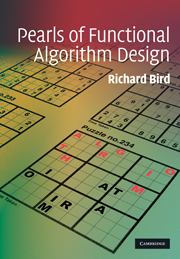Book contents
- Frontmatter
- Contents
- Preface
- 1 The smallest free number
- 2 A surpassing problem
- 3 Improving on saddleback search
- 4 A selection problem
- 5 Sorting pairwise sums
- 6 Making a century
- 7 Building a tree with minimum height
- 8 Unravelling greedy algorithms
- 9 Finding celebrities
- 10 Removing duplicates
- 11 Not the maximum segment sum
- 12 Ranking suffixes
- 13 The Burrows–Wheeler transform
- 14 The last tail
- 15 All the common prefixes
- 16 The Boyer–Moore algorithm
- 17 The Knuth–Morris–Pratt algorithm
- 18 Planning solves the Rush Hour problem
- 19 A simple Sudoku solver
- 20 The Countdown problem
- 21 Hylomorphisms and nexuses
- 22 Three ways of computing determinants
- 23 Inside the convex hull
- 24 Rational arithmetic coding
- 25 Integer arithmetic coding
- 26 The Schorr–Waite algorithm
- 27 Orderly insertion
- 28 Loopless functional algorithms
- 29 The Johnson–Trotter algorithm
- 30 Spider spinning for dummies
- Index
30 - Spider spinning for dummies
Published online by Cambridge University Press: 05 March 2013
- Frontmatter
- Contents
- Preface
- 1 The smallest free number
- 2 A surpassing problem
- 3 Improving on saddleback search
- 4 A selection problem
- 5 Sorting pairwise sums
- 6 Making a century
- 7 Building a tree with minimum height
- 8 Unravelling greedy algorithms
- 9 Finding celebrities
- 10 Removing duplicates
- 11 Not the maximum segment sum
- 12 Ranking suffixes
- 13 The Burrows–Wheeler transform
- 14 The last tail
- 15 All the common prefixes
- 16 The Boyer–Moore algorithm
- 17 The Knuth–Morris–Pratt algorithm
- 18 Planning solves the Rush Hour problem
- 19 A simple Sudoku solver
- 20 The Countdown problem
- 21 Hylomorphisms and nexuses
- 22 Three ways of computing determinants
- 23 Inside the convex hull
- 24 Rational arithmetic coding
- 25 Integer arithmetic coding
- 26 The Schorr–Waite algorithm
- 27 Orderly insertion
- 28 Loopless functional algorithms
- 29 The Johnson–Trotter algorithm
- 30 Spider spinning for dummies
- Index
Summary
Oh what a tangled web we weave when first we practise to derive.
(With apologies to Sir Walter Scott)Introduction
Consider the problem of generating all bit strings a1a2 … an of length n satisfying given constraints of the form ai ≤ aj for various i and j. The generation is to be in Gray path order, meaning that exactly one bit changes from one bit string to the next. The transition code is a list of integers naming the bit that is to be changed at each step. For example, with n = 3, consider the constraints a1 ≤ a2 and a3 ≤ a2. One possible Gray path is 000, 010, 011, 111, 110 with transition code [2, 3, 1, 3] and starting string 000.
The snag is that the problem does not always have a solution. For example, with n = 4 and the constraints a1 ≤ a2 ≤ a4 and a1 ≤ a3 ≤ a4, the six possible bit strings, namely 0000, 0001, 0011, 0101, 0111 and 1111, cannot be permuted into a Gray path. There are four strings of even weight (the numbers of 1s) and two of odd weight, and in any Gray path the parity of the weights has to alternate.
Constraints of the form ai ≤ aj on bit strings of length n can be represented by a digraph with n nodes in which a directed edge i ← j is associated with a constraint ai ≤ aj.
Information
- Type
- Chapter
- Information
- Pearls of Functional Algorithm Design , pp. 258 - 274Publisher: Cambridge University PressPrint publication year: 2010
